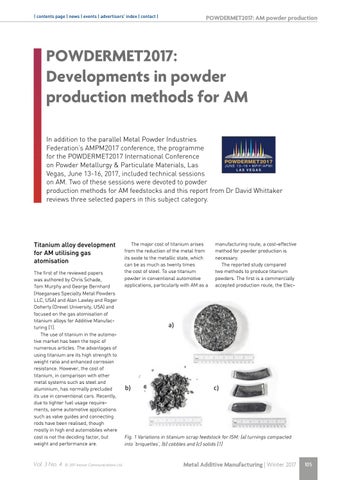| contents page | news | events | advertisers’ index | contact |
POWDERMET2017: AM powder production
POWDERMET2017: Developments in powder production methods for AM In addition to the parallel Metal Powder Industries Federation’s AMPM2017 conference, the programme for the POWDERMET2017 International Conference on Powder Metallurgy & Particulate Materials, Las Vegas, June 13-16, 2017, included technical sessions on AM. Two of these sessions were devoted to powder production methods for AM feedstocks and this report from Dr David Whittaker reviews three selected papers in this subject category.
Titanium alloy development for AM utilising gas atomisation The first of the reviewed papers was authored by Chris Schade, Tom Murphy and George Bernhard (Hoeganaes Specialty Metal Powders LLC, USA) and Alan Lawley and Roger Doherty (Drexel University, USA) and focused on the gas atomisation of titanium alloys for Additive Manufacturing [1]. The use of titanium in the automotive market has been the topic of numerous articles. The advantages of using titanium are its high strength to weight ratio and enhanced corrosion resistance. However, the cost of titanium, in comparison with other metal systems such as steel and aluminium, has normally precluded its use in conventional cars. Recently, due to tighter fuel usage requirements, some automotive applications such as valve guides and connecting rods have been realised, though mostly in high end automobiles where cost is not the deciding factor, but weight and performance are.
Vol. 3 No. 4 © 2017 Inovar Communications Ltd
The major cost of titanium arises from the reduction of the metal from its oxide to the metallic state, which can be as much as twenty times the cost of steel. To use titanium powder in conventional automotive applications, particularly with AM as a
manufacturing route, a cost-effective method for powder production is necessary. The reported study compared two methods to produce titanium powders. The first is a commercially accepted production route, the Elec-
a)
b)
c)
Fig. 1 Variations in titanium scrap feedstock for ISM: (a) turnings compacted into ‘briquettes’, (b) cobbles and (c) solids [1]
Metal Additive Manufacturing | Winter 2017
105
